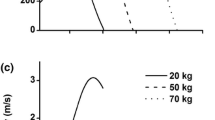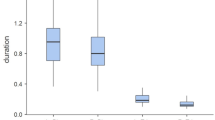Abstract
Previous studies of multijoint arm movements have shown that the CNS holds arm kinematics constant in different situations by predictively compensating for the effects of interaction torques. We determined whether this was also the case for wrist joint flexion in natural overarm throws performed by skilled subjects in 3D, a situation where large passive torques can occur at the wrist. Specifically, we investigated whether wrist flexion amplitudes are held constant in throws of different speeds. Joint rotations were recorded at 1,000 Hz with the search-coil technique. Contrary to a previous study on constrained 2D throwing, indirect evidence was found that in fast throws passive torques associated with forearm deceleration were exploited to increase wrist flexion velocity. This increase in wrist flexion velocity was associated with constant wrist flexion amplitudes at ball release (mean 27°) for throws of different speeds. Furthermore, final wrist flexion positions after ball release were similar for a particular subject irrespective of the speed of the throw. This was associated in faster throws with increased magnitudes of wrist flexor and wrist extensor EMG activity which damped passive torques associated with forearm angular deceleration. It is concluded that wrist flexion in overarm throws of different speeds is produced by central signals which precisely control net joint torque by both exploiting and damping passive torques during different parts of the throw to keep wrist joint angular position parameters constant. As such the results show that control strategies for natural 3D throwing are different from those for constrained 2D throwing.









Similar content being viewed by others
References
Almeida GL, Hong DA, Corcos D, Gottlieb GL (1995) Organizing principles for voluntary movement: extending single-joint rules. J Neurophysiol 74:1374–1381
Barrentine SW, Matsuo T, Escamilla RF, Fleisig GS, Andrews JR (1998) Kinematic analysis of the wrist and forearm during baseball pitching. J Appl Biomech 14:24–39
Bastian AJ, Martin TA, Keating JG, Thach WT (1996) Cerebellar ataxia: abnormal control of interaction torques across multiple joints. J Neurophysiol 76:492–509
Bernstein NA (1967) The coordination and regulation of movements. Pergamon, New York
Cooper SE, Martin JH, Ghez C (2000) Effects of inactivation of the anterior interpositus nucleus on the kinematic and dynamic control of multijoint movement. J Neurophysiol 84:1988–2000
Dounskaia NV, Swinnen SP, Walter CB, Spaepen AJ, Verschueren SM (1998) Hierarchical control of different elbow-wrist coordination patterns. Exp Brain Res 121:239–254
Elliott B, Grove JR, Gibson B, Thurston B (1986) A three-dimensional cinematographic analysis of the fastball and curveball pitches in baseball. Int J Sport Biomech 2:20–28
Feldman AG, Levin MF (1995) The origin and use of positional frames of reference in motor control. Behav Brain Res 18:723–806
Feldman AG, Adamovich SV, Ostry DJ, Flanagan JR (1990) The origin of electromyograms—explanations based on the equilibrium point hypothesis. In: Winters JM, Woo SL-Y (eds) Multiple muscle systems: biomechanics and movement organization. Springer, New York, pp 195–213
Flanagan JR, Wing AM (1997) The role of internal models in motion planning and control: evidence from grip force adjustments during movements of hand-held loads. J Neurosci 17:1519–1528
Galloway JC, Koshland GF (2002) General coordination of shoulder, elbow and wrist dynamics during multijoint arm movements. Exp Brain Res 142:163–180
Gottlieb GL (1998) Rejecting the equilibrium-point hypothesis. Motor Control 2:10–12
Gribble PL, Ostry DJ (1999) Compensation for interaction torques during single- and multijoint limb movement. J Neurophysiol 82:2310–2326
Hirashima M, Kudo K, Ohtsuki T (2003) Utilization and compensation of interaction torques during ball-throwing movements. J Neurophysiol 89:1784–1796
Hoffman DS, Strick PL (1990) Step-tracking movements of the wrist in humans. II. EMG analysis. J Neurosci 10:142–152
Hoffman DS, Strick PL (1993) Step-tracking movements of the wrist. III. Influence of changes in load on patterns of muscle activity. J Neurosci 13:5212–5227
Hollerbach JM, Flash T (1982) Dynamic interactions between limb segments during planar arm movement. Biol Cybern 75:67–77
Hore J, Watts S, Tweed D (1996) Errors in the control of joint rotations associated with inaccuracies in overarm throws. J Neurophysiol 75:1013–1025
Hore J, Watts S, Tweed D (1999) Prediction and compensation by an internal model for back forces during finger opening in an overarm throw. J Neurophysiol 82:1187–1197
Hore J, Watts S, Leschuk M, MacDougall A (2001) Control of finger grip forces in overarm throws made by skilled throwers. J Neurophysiol 86:2678–2689
Hoy MG, Zernicke RF (1986) The role of intersegmental dynamics during rapid limb oscillations. J Biomech 19:867–877
Karst GM, Hasan Z (1987) Antagonist muscle activity during human forearm movements under varying kinematic and loading conditions. Exp Brain Res 67:391–401
Koshland GF, Galloway JC, Nevoret-Bell CJ (2000) Control of the wrist in three-joint arm movements to multiple directions in the horizontal plane. J Neurophysiol 83:3188–3195
Latash ML, Aruin AS, Shapiro MB (1995) The relation between posture and movement: study of a simple synergy in a two-joint task. Hum Mov Sci 14:79–107
Mustard BE, Lee RG (1987) Relationship between EMG patterns and kinematic properties for flexion movements at the human wrist. Exp Brain Res 66:247–256
Pfann KD, Hoffman DS, Gottlieb GL, Strick PL, Corcos DM (1998) Common principles underlying the control of rapid, single degree-of-freedom movements at different joints. Exp Brain Res 118:35–51
Phillips SJ, Roberts EM, Huang TC (1983) Quantification of intersegmental reactions during rapid swing motion. J Biomech 16:411–417
Putnam CA (1991) A segment interaction analysis of proximal-to-distal sequential segment motion patterns. Med Sci Sports Exerc 23:130–144
Putnam CA (1993) Sequential motions of body segments in striking and throwing skills: descriptions and explanations. J Biomech 26 Suppl 1:125–135
Sainburg RL, Ghilardi MF, Poizner H, Ghez C (1995) Control of limb dynamics in normal subjects and patients without proprioception. J Neurophysiol 73:820–835
Sainburg RL, Ghez C, Kalakanis D (1999) Intersegmental dynamics are controlled by sequential anticipatory, error correction, and postural mechanisms. J Neurophysiol 81:1045–1056
Sakurai S, Ikegami Y, Okamoto A, Yabe K, Toyoshima S (1993) A three-dimensional cinematographic analysis of upper limb movement during fastball and curveball baseball pitches. J Appl Biomech 9:47–65
Schneider K, Zernicke RF, Schmidt RA, Hart TJ (1989) Changes in limb dynamics during the practice of rapid arm movements. J Biomech 22:805–817
Schweighofer N, Arbib MA, Kawato M (1998a) Role of the cerebellum in reaching movements in humans. I. Distributed inverse dynamics control. Eur J Neurosci 10:86–94
Schweighofer N, Spoelstra J, Arbib MA, Kawato M (1998b) Role of the cerebellum in reaching movements in humans. II. A neural model of the intermediate cerebellum. Eur J Neurosci 10:95–105
Shadmehr R, Mussa-Ivaldi FA (1994) Adaptive representation of dynamics during learning of a motor task. J Neurosci 14:3208–3224
Smith JL, Zernicke RF (1987) Predictions for neural control based on limb dynamics. Trends Neurosci 10:123–128
Suzuki M, Shiller DM, Gribble PL, Ostry DJ (2001) Relationship between cocontraction, movement kinematics and phasic muscle activity in single-joint arm movement. Exp Brain Res 140:171–181
Timmann D, Citron R, Watts S, Hore J (2001) Increased variability in finger position occurs throughout overarm throws made by cerebellar and unskilled subjects. J Neurophysiol 86:2690–2702
Topka H, Konczak J, Schneider K, Boose A, Dichgans J (1998) Multijoint arm movements in cerebellar ataxia: abnormal control of movement dynamics. Exp Brain Res 119:493–503
Ulrich BD, Jensen JL, Thelen E, Schneider K, Zernicke RF (1994) Adaptive dynamics of the leg movement patterns of human infants: II. Treadmill stepping in infants and adults. J Mot Behav 26:313–324
Vaughn RE (1985) Three dimensional kinematics of the baseball pitch. In: Terauds J, Barham JN (eds) Biomechanics in sports. Research Center for Sports, Del Mar, CA, pp 72–78
Wierzbicka MM, Wiegner AW, Shahani BT (1986) Role of agonist and antagonist muscles in fast arm movements in man. Exp Brain Res 63:331–340
Yamazaki Y, Ohkuwa T, Itoh H, Suzuki M (1994) Reciprocal activation and coactivation in antagonistic muscles during rapid goal-directed movements. Brain Res Bull 34:587–593
Yamazaki Y, Itoh H, Ohkuwa T (1995) Muscle activation in the elbow-forearm complex during rapid elbow extension. Brain Res Bull 38:285–295
Acknowledgements.
We thank L. van Cleeff for technical assistance. D.B. Debicki performed and analyzed experiments for his MSc thesis. The work was supported by the Canadian Institute of Health Research.
Author information
Authors and Affiliations
Corresponding author
Rights and permissions
About this article
Cite this article
Debicki, D.B., Gribble, P.L., Watts, S. et al. Kinematics of wrist joint flexion in overarm throws made by skilled subjects. Exp Brain Res 154, 382–394 (2004). https://doi.org/10.1007/s00221-003-1673-4
Received:
Accepted:
Published:
Issue Date:
DOI: https://doi.org/10.1007/s00221-003-1673-4




